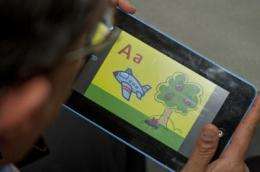Low-cost electronic tablet proves worth in Indian classroom

The U.S.- and Singapore-based creators of the low-cost I-slate electronic tablet are preparing for full-scale production now that a yearlong series of tests has shown that the device is an effective learning tool for Indian children.
The I-slate, an electronic version of the hand-held blackboard slates used by millions of Indian children, will eventually be solar-powered for use in classrooms that lack electricity. It is being developed by researchers at the Institute for Sustainable and Applied Infodynamics (ISAID), a joint program of Rice University in Houston and Nanyang Technological University (NTU) in Singapore. When mass-produced, the solar-powered I-slate is expected to cost less than $50 (64 Singapore dollars).
"Our study clearly shows the I-slate is an effective learning tool for all students, regardless of their learning ability," said computer scientist and I-slate creator Krishna Palem, director of ISAID. "The first production I-slates will be pre-loaded with lessons for mathematics, science and social studies."
Palem, a Nanyang Visiting Professor at NTU and Rice's Ken and Audrey Kennedy Professor of Computing, first conceived the power-saving educational tablet in early 2009. Late last summer, Palem's Rice-NTU team began working with the Indian nonprofit Villages for Development and Learning Foundation (ViDAL) to test I-slate prototypes in a class of 10- to 13-year-olds at Mohd Hussainpalli village, about 70 miles southwest of Hyderabad.
In March, the researchers examined whether the I-slate helped students' improve in mathematics. Students use a stylus to tap and write out mathematics problems on the I-slate. They get immediate feedback about correct and incorrect answers. When answers are incorrect, the machine gives hints and tips about how to correct mistakes.
Using a series of sophisticated measures, the ISAID team analyzed each student's performance and improvement. Students were also surveyed about the features of the I-slate that were most and least useful. Palem said the tests and surveys confirmed the I-slate was effective and provided the ISAID team with valuable information needed to finalize the I-slate's design.

"We know more than 90 percent of what we need to know at this point," Palem said. "We've settled the hardware questions, and that is central to the manner in which the lessons are taught and the manner in which the students interact with the I-slate."
The hardware and graphic content for the I-slate must be developed in tandem because they will ultimately use a revolutionary new low-power computer chip -- another of Palem's inventions. The new chip will cut the power requirements for the I-slate in half and allow the device to run on solar power from small panels similar to those found on handheld calculators. The current I-slate hardware, which uses conventional chips, was designed by ISAID's Vincent Mooney, associate professor of electrical and computer engineering at Georgia Institute of Technology.
ISAID team members in Switzerland, Singapore and the U.S. are developing the first production version of the low-power computer chip. Solar-powered I-slates containing the new chips are due for production in mid-2012.
Palem said a Los Angeles-based consortium of media and content developers headed by Marc Mertens is putting the finishing touches on the math, science and social studies curriculum. Both the content and the finalized I-slate design will be rolled out with traditional chips this fall. About 50 students in Mohd Hussainpalli and other nearby villages will receive battery-powered versions of these slates for a six-month trial.
"Working with Marc, we're planning to bundle a social-networking element into the software that will allow the students to work collaboratively on writing assignments," Palem said.
"We are at an exciting stage and based on rigorous testing, we have achieved quite a few firsts in this early phase of adoption," said Rajeswari Pingali, ViDAL founding chairperson. "Soon students will be able to take the slates home for use and improving their learning outcomes. We spoke to all parents of the children; they too are equally excited about the I-slate. We are particularly happy about the potential benefits for young girls, who otherwise might be married away at a very early age."
Provided by Rice University

















